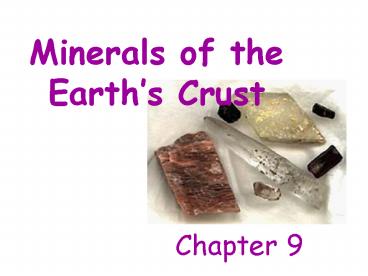Minerals of the Earths Crust - PowerPoint PPT Presentation
1 / 38
Title:
Minerals of the Earths Crust
Description:
One mineral can have different colors. Impurities can alter color. Some change color when exposed to air. Way a mineral ... 8. Topaz. 9. Corundum. 10. Diamond ... – PowerPoint PPT presentation
Number of Views:287
Avg rating:3.0/5.0
Title: Minerals of the Earths Crust
1
Minerals of the Earths Crust
- Chapter 9
2
Mineral a naturally occurring substance formed
in the Earth
- Inorganic
- Always a crystalline solid
- Definite chemical composition
3
Over 2,000 are known!
4
Identifying Minerals Color
- Most easily observed property
- Yet, least useful property
5
Identifying Minerals ColorWhy it is the least
useful property
- Different minerals have the same color
- One mineral can have different colors
- Impurities can alter color
- Some change color when exposed to air
- Way a mineral shines in reflected light distorts
color
6
Identifying Minerals Luster
- Way a mineral shines in reflected light
7
Identifying Minerals Luster
- Metallic
- shines like polished metal
Pyrite Fools Gold
8
Identifying Minerals Luster
- Nonmetallic
- does not shine like metal
9
Identifying Minerals Luster
- Pearly
- like a pearl
Talc
10
Identifying Minerals Luster
- Greasy
Turquoise
11
Identifying Minerals Luster
- Vitreous
- like shining glass
Amethyst
12
Identifying Minerals Luster
- Resinous
- like wax
13
Identifying Minerals Luster
- Dull or Earthy
Bauxite
14
Identifying Minerals Crystal Shape
- The shape of a crystal results from the way the
atoms of a mineral come together as the mineral
forms
15
Identifying Minerals Streak Test
- Color of a minerals powder form
- Usually, streak is not the same color as the
mineral - Streak doesnt vary
16
Identifying Minerals Streak Test
- Metallic mineral has dark streak
- Nonmetallic colorless or light streak
17
(No Transcript)
18
(No Transcript)
19
Identifying Minerals Cleavage
- The splitting of a mineral along certain flat
surfaces - Related to the types of bonds in the internal
structure of the mineral
20
Identifying Minerals Cleavage
21
Identifying Minerals Fracture
- the way a mineral tends to break
22
Identifying Minerals Fracture
jagged
Splintery
23
Identifying Minerals Hardness
- Resistance to being scratched
- Mohs hardness scale
24
- Mohs Scale, identified numerically by standard
minerals, from 1 (softest) to 10 (hardest)
- 1. Talc
- 2. Gypsum
- 3. Calcite
- 4. Fluorite
- 5. Apatite
- 6. Orthoclase
- 7. Quartz
- 8. Topaz
- 9. Corundum
- 10. Diamond
25
To remember the Mohs scale try remembering this
phrase
- The Geologist Can Find An Ordinary Quartz,
(that) Tourists Call Diamond!
26
Tools for Testing Hardness
- You typically do not carry around a supply of the
10 minerals on the hardness scale. However, you
can use the following items to help estimate the
hardness of a mineral
27
Tools for Testing Hardness
- finger nail (H 2.5)
- penny (H 3.5)
- common nail (H 4.5)
- glass plate (H 5.5)
28
Identifying Minerals Special Properties
- Acid test
http//www.westhamptonbeach.k12.ny.us/Teachers/Coh
en/sciweb/earthscience/sedimentary/Mvc-327w.mpg
29
Identifying Minerals Special Properties
- Magnetic test
30
Identifying Minerals Special Properties
- Taste test
Some minerals have a distinct taste. Never do
this test after the acid test!
31
Common Rock-forming Minerals
Quartz
32
Feldspar
Mica
33
Talc
Amphiboles
34
Galena
Halite
35
Biotite
Calcite
36
Hematite
Pyrite
37
Magnitie
Olivine
38
Garnets

